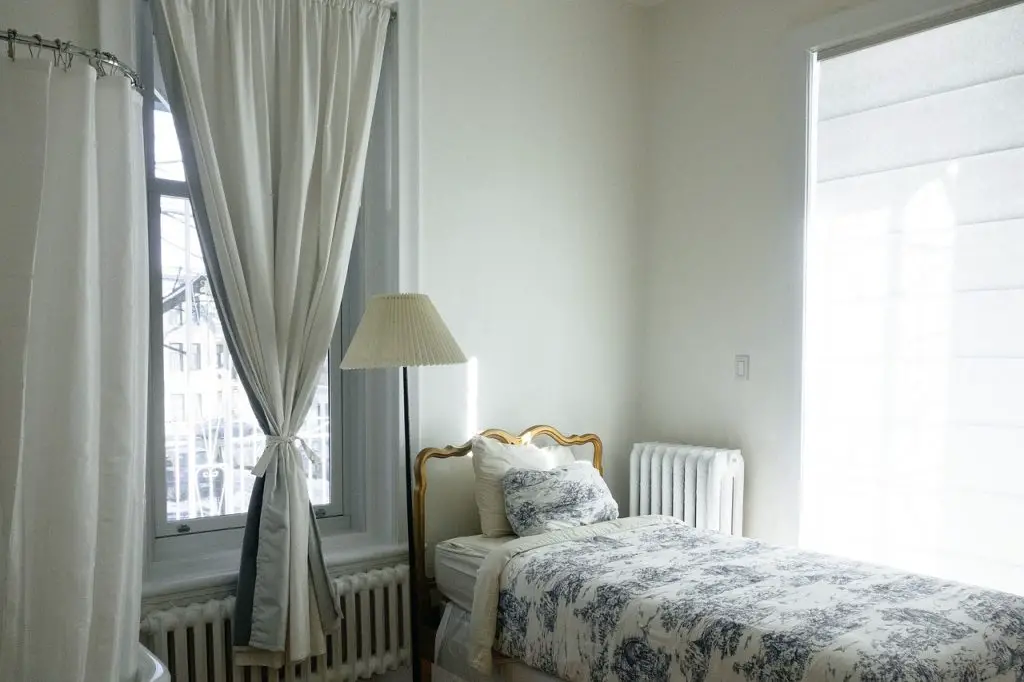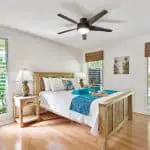
How to make sliding windows soundproof? This is one of the most common questions I receive over and over again.
The reason for this is simple, people (this might include you) are having problems lessening the noise that is entering the room through the window.
I have the same issue too. In fact, not too long ago, I asked the same question. I was trying to find ways on how I could soundproof the sliding windows that disturbed me most nights.
Today, I would like to share the strategies that I have implemented in my sliding windows. The purpose of this article is to help you make your sliding windows soundproof too.
The good news is that the steps that I am going to share with you are easy and doable. And most importantly, the techniques are inexpensive.
6 Ways to Make Sliding Windows Soundproof
Windows are sometimes difficult to soundproof because of their structure. Because of this, in most cases, windows are left as they are. The problem, however, is that windows become the passage of disturbing noise from the outside.
If you hear noise from your neighbors or from the street, the first thing to consider is your window. Depending on the materials being used and the quality of the installation, windows are the source of noise pollution.
Soundproofing a sliding window involves many strategies and different price ranges. You can easily add materials to make soundproofing even easier. But this usually costs several hundreds of dollars.
However, if you have a low budget and want to carry out the soundproofing project for your sliding windows, this guide is for you.
The following techniques are not only applicable to sliding windows but also for virtually any type of windows. The only thing you need other than the materials is creativity. The more creative you are, the more successful you will be in your project.
So, without further ado, here’s how to make sliding windows soundproof.
Step 1: Seal the Air Gaps
As you may already know, soundwaves are very good at finding weak spots to pass through. In most cases, windows have the weakest resistance to sound. As a result, the windows are the common entrance for the soundwaves.
This is a common problem, especially with old model buildings or houses. The windows are not tightly fitting on all the edges.
Windows with many air gaps allow more soundwaves to travel inside. If the window is poorly installed, it makes the whole room vulnerable to noise pollution.
That said, it is extremely important to fix the air gaps by sealing them. Doing this will block the soundwave, therefore, making the room quieter.
There are many ways you can do to seal the air gaps. Consider the following:
Green Glue
Green Glue Noise-proofing Sealant is one of the easiest materials to use in sealing the cracks on the walls and air gaps. It is an effective and fast-drying soundproofing glue.
You might be thinking that this is just a regular glue. And so you may be tempted to use a traditional glue to fix the air gaps. But I don’t recommend using traditional glue.
Instead, use the green glue or other glue that is designed specifically for soundproofing. Sealants like this do a very good job of inhibiting the sound and vibration that are passing through the window. They actually absorb sound themselves, in addition to preventing leakage around the edges.
Green glue is used in most soundproofing projects of all sorts. Additionally, this is a simple and inexpensive soundproofing tool for soundproofing the air gaps of the window.
High-Density Foam Tape
If you want a lot easier to use soundproofing material for your sliding window, maybe you want to try the High-Density Foam Tape.
This material has an adhesive layer that makes it easy to apply to air gaps. It’s easy to apply to the bottom of a vertical (up and down) sliding window without hassle.
Acoustic Putty
So far, the materials I mentioned work well on even and flat solid surfaces. But when dealing with uneven and awkward surfaces, they might not be able to function the way you want.
Fortunately, there are materials out there that can do the job. One of them is Acoustic Putty.
This acoustic putty would act as a tape. It can be molded according to the surface or gaps you want to fix. If used properly, it will provide a dense sound insulation layer.
This material is commonly used in huge buildings to protect electrical boxes. The purpose is to contain the sound in the box, making the electrical boxes quiet.
There you go. You have my quick tips on how to make sliding windows soundproof. These are just the simple soundproofing materials you can easily apply to your windows.
The good news about these materials is that despite being easy to use, they are also inexpensive. If you have a tight budget for your project, then these techniques might be perfect for you.
Step 2. Upgrade Curtains
Suppose that you were able to minimize the sound by applying the previous strategy and you still hear outside noise. The next thing you can do is to add mass to the surface of the window.
The mass that I’m talking about here is any soundproofing materials that could be hung on the surface of the window. The most effective for me is putting thick curtains on the window.
Thick curtains do a very good job of absorbing and blocking the sound from outside noise. Mass soundproofing materials like this will block and absorb the sound from the outside before it reaches inside.
Most of the time, curtains are used for decorative purposes only. But the functions of these materials are beyond what you might have imagined.
For maximum result, there are curtains that are specifically designed for making a room or space quiet. The only drawback is that these curtains are dense and heavy. In fact, for the best result, choose the one that has the heaviest per unit area.
There are many benefits to choosing these curtains. Because they have more mass and are denser, they are:
- Able to block the light from outside
Heavy and denser curtains are not only good for soundproofing but also for controlling the light that enters the room. If you are working on a job at night and sleeping in the morning, you probably want to keep the room dim. Heavy curtains, in this case, could really help.
- Energy efficient
Heavy curtains not only block the sound and light from the outside, but they also help maintain the temperature inside. Therefore, these materials are energy efficient. If you are using air-conditioning, the curtains keep the coolness inside therefore maximizing the energy being utilized.
If you want to apply curtains on your sliding window, here are the curtains that are designed to perform this purpose.
Noise Reducing Curtains
An excellent example of noise reducing curtains is the Nicetown Blackout Curtains Panels for Bedroom. Besides providing the soundproofing function, this material blocks about 99% of the light from the outside. It also serves as thermal insulation. These curtains come in lots of colors, and do not fade despite long-time use.
Using these curtains assures you quiet sleep during night or day. Not only that, this curtain adds beauty to your interior ambiance.
Lastly, because this curtain is machine washable, you’ll have no problem with washing. They’re machine washable, using a mild detergent.
What makes these curtains heavy is their triple weave design, making them effective in absorbing or blocking sound and insulating from heat.
Obviously, the more dense and the more mass curtains have, the better the soundproofing and insulating result.
Acoustic Soundproof Curtains
The other option is to use acoustic soundproof curtains. These curtains are more expensive, more durable and more effective. These curtains are made to block about 90% of the outside noise.
Although these curtains are heavy, they are easy to roll sideward if you need light or air directly from the outside. If you don’t deliberately roll the curtains towards the side of the window, no light could possibly penetrate the room.
Aside from blocking the light, the curtains also do a better job to block the sound from outside. The main purpose of this material is to soundproof the room by covering the window.
Techniques to Correctly Hang the Sound Dampening Curtains
When using soundproofing curtains on sliding windows, try to use the wider ones. This will allow you to pleat the curtains, making multiple folds. This means that the curtain blocking the sound is now thicker. The thicker it comes, of course, the more effective it will be in soundproofing the sliding window. And, of course, you’ll want the curtain to extend well past the window on both ends, since sound doesn’t travel in a straight line, so will escape around the ends.
To achieve the best result, you can use two curtains instead of one. This is will ensure more pleats and thicker soundproofing material for blocking the sound on the sliding window.
However, you need to make sure that the curtain rod is strong enough to hold the curtains. If you need to change the rod, do it before adding the curtains.
Step 3. Make Your Own Soundproofing Curtains
If you don’t want to buy soundproofing curtains for your sliding windows, you can make your own. This commonly happens if you can’t find the perfect curtain for the shape of your sliding window.
Secondly, you might want to minimize expenses. Thus, instead of buying expensive curtains, you might want to make your own. Making your own soundproofing curtain gives you the opportunity to apply the design you want to have.
When making your own soundproofing curtains for your windows, you should remember the following:
- Heavy and thick curtains do a very good job of blocking the outside noise.
When selecting the materials that will be used to make curtains, you need to have suitable materials. Thick, heavy fabrics work best. Good examples of these materials are suede, velvet, and synthetic velour.
You have to remember though that these materials are highly flammable. Take safety precaution for your room and the entire house, by making sure there aren’t electric heaters or other heat sources too close to the curtains.
- The curtains should cover the entire window
Make sure that the soundproofing curtain you use for the sliding window covers from well above the window, to well below the window, and that it overlaps both sides of the window by several inches as well.
- Pleat the curtain to maximize the soundproofing effect
As you already know, pleating the curtain makes it thicker, which in turn makes the materials even more effective.
If you can, choose a wider curtain to make the pleating easier. This is especially applicable when dealing with a double sliding window. The wider the curtain, the better the effect.
- Use a strong rod
Using thick curtains requires a strong and durable curtain rod. You can use different rod sizes as you need them. But whatever you choose, make sure it is strong enough.
Using Commercial Pleated Curtains
Sometimes, along the way, we may realize that making your own soundproofing curtain for sliding windows is more difficult than what you previously thought.
At this point, you might want to consider buying thick blackout curtains. This is a great soundproofing material for the sliding window, and adds the extra benefits of blocking out light and insulating from heat and cold.
For the best results, you can enhance the soundproofing effect by adding blackout panels. You can add these to the existing curtains of your sliding windows.
Step 4. Apply a Window Plug or Barrier
If you want to minimize disturbing sounds from outside of your room, the ultimate method is to use a window plug.
Applying this technique though requires that the plug perfectly fits in the sliding window to close all air gaps that the sound could possibly pass through.
Like other soundproofing materials for windows, the plug must be thick and dense enough to block the sound. But remember that the plug itself should remain light enough for easy moving.
Now, you might be wondering how you can make a plug for your sliding window.
Making a Window Plug
Making a window plug is actually very doable. If you are a newbie on this, don’t worry, this section is actually for you.
You start by making all the measurements correctly. Remember the old carpenter’s rule: “measure twice, cut once”. Having the correct length and thickness is crucial to this process.
To do this, you need some materials:
- Soundproofing Mat
- 2 Cupboard handles
- Fiberboard
- Green Glue
First Step
As mentioned, the first step is to measure the window’s frame to have an idea of how deep the window sill is. The thickness of the soundproofing mat depends on the depth of the sill. If the sill is two-inches deep, you need a 1-inch thick mat; a 4-inch window sill needs a 2-inch mat, and so on.
There are several types of acoustic mats you can choose from. These materials were originally designed for soundproofing car engine noise.
When using this mat for soundproofing sliding windows, you just need a perfect size. The good news is that acoustic mats come in multiple sizes and thicknesses that will fit your project.
The mat should be wider and taller than the window sill. This is to make sure that the air gaps are covered. My advice is to provide at least a 1-inch overlap on all sides of the sill.
Second Step
The next thing you need to do is to make a backing board for the window plug. This will not only add to the mass of the plug but also allows you to attach the handles.
The size of the backing board should be equal to the size of the window sill. Meaning, the acoustic foam will stick out 1-inch on all sides.
Third Step
After the acoustic foam is stuck to the backing board, you are now ready to make and install the handle. The handle will make is easier to insert and remove the window plug from the window sill.
There are many materials you can use to do this. You can try the cupboard handles or straps.
If you want, you can add another layer of acoustic foam to the backside of the window plug. But of course, this is a matter of personal preference.
Other Options for Soundproofing Sliding Windows
If making a window plug is impossible for your situation, don’t worry, there are other options you can consider.
The strategy that I am talking about here is the use of an Acoustic Barrier. This is a great option if you cannot fit a window plug to your window.
This material is designed to soundproof a room by limiting the sound transmission coming from the outside. The good thing about this material is that it is dense and thick enough to absorb sound.
You can hang it over the sliding window you want to soundproof. It functions like a window plug but requires no effort for constructing the plug.
Aside from using the Acoustic Barrier, another great option is to use Fiberglass Panel. This material is made of dense fiberglass. You can easily attach it with hooks to a curtain rod.
Lastly, is Mass Loaded Vinyl. I talked about this soundproofing material in my other post on how to soundproof ceiling in apartments. But this material is applicable to virtually any soundproofing projects including a sliding window.
What makes this a great material is its density and thickness. These features allow the material to absorb or block the noise. This material is clearly effective in making sliding windows soundproof.
Step 5. Add an Extra Sound Insulating Layer
Another way to soundproof a sliding window is by installing another layer of sound insulation. One of the best ways to do this is by attaching layer of acrylic on the existing sliding window. Doing this lessens the noise that is entering the room.
You can do this on your own or have somebody to do it. If you have enough budget though, you can buy the materials that are ready to install.
One of the benefits of using acrylic is that, unlike using the window plug, acrylic is transparent. As a result, it allows the light to pass through making it okay to remain in its position during the day. It only blocks the sound but not light.
However, what I learned from my personal experience is that acrylic is not as effective as other dense and heavier soundproofing materials. So you better figure out the best option.
Step 6. Upgrade the Old Windows
One of the biggest problems with sliding windows is found in older ones. This is because older buildings come with older window designs and installations.
Most of the older windows have single-pane windows that offer ineffective and weak insulation and soundproofing capabilities.
As a result, the heat and noise pollution from the outside could readily pass through the sliding window. If that is the case, you can add or totally replaced the old windows with the new ones.
Of course, this requires a little higher budget. But this is the ultimate solution to the perennial problem.
I hope that I have given value here. It is my hope that I’ve been able to share some of the more helpful tips on how to make sliding windows soundproof in a few ways.
By now, you probably have an idea what are the materials you need and how much you need to spend on your soundproofing project.
Although I recommend using any of the tips I shared above, I strongly encourage you to explore other possibilities as well.
If you couldn’t find the strategy you want to implement to your project, then read more tips. You can find additional information on this in my Soundproofing Guide.
Related Questions:
Can you soundproof sliding windows? The answer is yes. In fact, you can do it yourself or buy one. Soundproof windows have one thing in common – they have a lesser number of shutters. Effective soundproof windows are installed in marble frames for optimal sound reduction effect.
Do soundproof windows need a separate section? Yes, a separate section is necessary for installing soundproof windows. In addition, the soundproof window is made way differently from the regular ones.
How much do soundproof windows cost? The price of soundproof windows is a little higher than the regular windows. The reason is obvious – soundproof windows are created for specific purposes. Secondly, the type and quality of materials being used also have a high cost. Adding these factors together, buying a soundproof window would typically cost you more than buying the regular ones.







